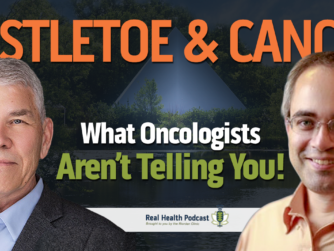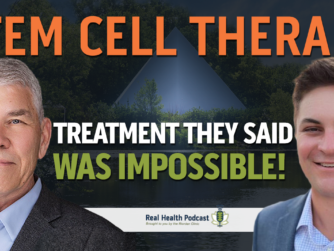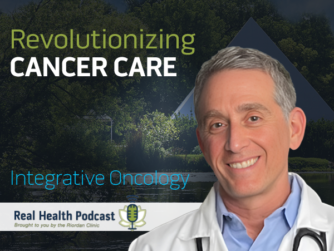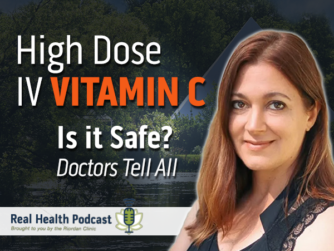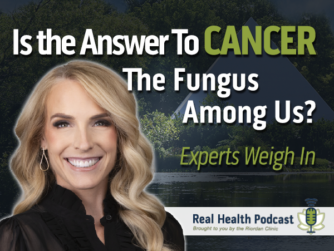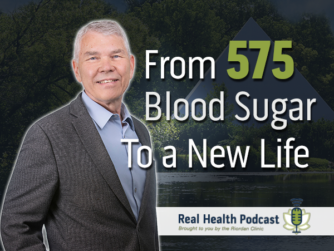In the latest episode of the Real Health Podcast, Dr. Ron Hunninghake, MD, and Ryan Sternagel, founder of The Stern Method, delve into the impactful story behind saving Ryder, Ryan’s son who was diagnosed with cancer at only one year old. Ryan shares how his family’s experience throughout Ryder’s healing journey brought them to learn about building a healthy home free of toxins and how an integrative approach to healthcare was the best solution for their family.
Links
Read the transcription here:
Learn more about the host:
Dr. Ron Hunninghake: https://riordanclinic.org/staff/ron-hunninghake-md/
Learn more about the guest:
https://thesternmethod.com/our-story/
https://www.instagram.com/thesternmethod/?hl=en
https://www.youtube.com/c/TheSternMethod
Read the Transcript
Disclaimer: The information contained on the Real Health Podcast and the resources mentioned are for educational purposes only. They’re not intended as and shall not be understood or construed as medical or health advice. The information contained on this podcast is not a substitute for medical or health advice from a professional who is aware of the facts and circumstances of your individual situation. Information provided by hosts and guests on the Real Health Podcast, or the use of any products or services mentioned, does not create a practitioner patient relationship between you and any persons affiliated with this podcast.
Intro: This is the Real Health Podcast brought to you by Riordan Clinic. Our mission is to bring you the latest information and top experts in functional and integrative medicine to help you make informed decisions on your path to real health.
Dr. Ron Hunninghake: So welcome, everyone. This is Dr. Ron Hunninghake. This is the Real Health Podcast, another episode, and I’m pleased to have as my guest today, Mr. Ryan Sternagel. Ryan, welcome. And I’m pleased to hear that you, as a family, went through, well, it’s not pleasing, but you went through some difficult times, but it was an impetus for you to transform you and your family into a more integrative lifestyle, big picture, integrative lifestyle. And I was wondering if you would share a little bit of that story with our listening audience.
Mr. Ryan Sternagel: Yeah, it was a Lord works in mysterious ways type situation, I suppose, Dr. Ron.
Dr. Ron Hunninghake: Yeah, sure.
Mr. Ryan Sternagel: Yeah. I was just thinking about it the other day, our son Ryder, my wife is Teddy. Our son Ryder was diagnosed just before his first birthday, 11 days before his first birthday, to be exact, with stage four neuroblastoma, which is typically a childhood cancer of the nervous system. Well, my wife found it because there was a big lump sticking out of his back, and then we went through the … I know it’s not unique to a lot of people who have been through this sort of thing, but yeah, had a hard time getting a diagnosis in the first place, took him to … And we were, you mentioned transformed to an integrative, we were nowhere near what we are today, but ate mostly organic food and was already doing the getting rid of EMF thing and getting rid of the chemicals in the house and all that stuff, so we were already pretty far down that road, which was, again, then when we did get a stage four cancer diagnosis for our 1-year-old, was like a, why us, type of thing.
So we had actually taken him to a naturopath at first, a naturopathic doctor pediatrician, who we felt pretty good about, but for some reason, got the … A lot of things started adding up at that point. He had a lump sticking out of his back, which was concerning, but then we started thinking, “Well, he’s also not only not walking just before his first birthday, but not even really crawling, barely even able to roll around on the floor.” He had had leg movement before, but then it went away, and he’s not really keeping anything down eating wise, and all this stuff. So we felt the lump on the back and all this stuff starts adding up in our heads, and ended up getting a referral for speech therapy for the keeping things down part, and physical therapy for the not walking stuff. It’s like, “Oh, come on, he’s got a lump in his back. Something’s going on here.”
Dr. Ron Hunninghake: So you weren’t getting any help with thinking about what had caused this. It was more like, “We’re going to try to fix this; we’re going to try to fix that,” but no understanding of the underlying factors that may have contributed to this.
Mr. Ryan Sternagel: Yeah, and it’s almost like we shouldn’t have brought up the other things, ’cause then … I don’t know. Anyway, that didn’t really sit well with us. We pressed for a referral to the local hospital that sees children, got in there. That guy told us … We thought it was a doctor we were talking to at first, turned out to be a physician’s assistant, and he told us to come back in six weeks if the lump was still there. I think that was on a Friday, and by Monday, we were calling back saying, “Look, there is a lump in our son’s back.” My wife had already basically, Doctor Google had diagnosed him with neuroblastoma at that point, just from mother’s intuition and clicking around. And everyone says, “Don’t do the Doctor Google thing.” But a lot of times, you get a lot further with that than the medical establishment, unfortunately.
Dr. Ron Hunninghake: Yeah.
Mr. Ryan Sternagel: So, yeah, they humored us with an ultrasound, and then the ultrasound did reveal that there was some sort of mass in there, so they had us come back for an MRI a couple of days later. And yeah, I’ll never forget when we got the MRI, when the doctor and the nurse, they said it would be a half hour. We were waiting, half hour passed, hour passed, hour and a half passed, probably close to a couple of hours later, the doctor and the nurse came back and they both had tears in their eyes, and then they gave us the news that he had stage four neuroblastoma. There was a large mass growing inside of his spine and out of it, and it was basically all just interwoven throughout his spinal cord. He had a couple of secondary tumors and metastasis to his hip bones. That was the start of our journey.
Dr. Ron Hunninghake: Did you go much further, in terms of conventional therapy, in terms of chemo or anything like that? Or is this the point where you said, “My gosh, what are the deeper causes here and what else can we do to help him heal?”
Mr. Ryan Sternagel: No, like I said, we were already fairly savvy to the fact that there was other stuff that you could be doing besides chemo, but then also weren’t necessarily opposed to doing some chemo if it turned out to be the right thing. And we were a little fiery and getting frustrated with the answers we were getting, and all that stuff. But we ended up saying we’d like a second opinion before launching into whatever treatment program they wanted to give us, because they were actually ready to start him on chemo before exactly even knowing what the diagnosis was, before the biopsy came back, before they got the pathology back, they just wanted to get him into chemo yesterday. And it’s like, “Well, come on, guys. You’re the same guys that were telling us to come back in six weeks, and now you’re telling us he needs to be in chemo yesterday. Can we have a day to figure this out?”
So we actually got the biopsy in the hospital. We did get a PICC line put in. The reason being, one, if we did decide to do chemo, then he’d be ready to do it. But then, two, obviously, we were already researching IV vitamin C and all these different IV therapies, and even IPT, and all these sorts of things. So figured, well, what the heck? Let’s get the line put in. That way, if we find somebody that’s able to do IV vitamin C and these sorts of things, we just have it set up and ready to go. And so, we got the line put in, brought him home.
And I think it was the next night, not the night after, but the next night, Ryder, Teddy was sleeping next to my wife, or sleeping with both of us in bed, and all of a sudden, Teddy noticed that he was burning up in the middle of the night, and we didn’t know what was going on. But yeah, he had a 100-something crazy high fever, I forget what it was, and started puking all over the place, and stuff coming out of both ends, and we didn’t know what was going on. So that was 90 miles an hour back to the hospital we had just left. And turned out he had gotten an infection, bloodstream staph infection, when he got that line in.
So at that point, we’re in the hospital on IV antibiotics and all that stuff, trying to clear the infection. It’s going to be a while, all of our dreams about traveling to Mexico or something like that to get him treated were out the window at that point. And so, we did consent to doing a round of chemo because we did know we needed to shrink that tumor in a hurry, because they were telling us originally that they didn’t even know, even if he survived the cancer, if he would ever walk, because there was so much obvious nerve damage-
Dr. Ron Hunninghake: Damage.
Mr. Ryan Sternagel: … going on.
So yeah, we weren’t, dogmatically, we’re not going to do chemo at all, especially given the circumstances. So we did a round, and took him home, and thought that was it, and we were going to be going back to doing our holistic research and all that stuff. This was a few weeks later, get a knock on the door from Child Protective Services, and apparently, the hospital had called them right after we left the first time and said we’re going to get a second opinion, and then, just being the government, it took them a few months or a few weeks to actually get around to following up on the case. But yeah, at that point, it became clear that if we didn’t keep playing ball and do exactly what the standard of care was, that they would intervene, as they put it. And so, then it became a choice of, well, do we lose our kid or do we do the best job integratively we can? So yeah, we did a few more rounds of chemo, and in the meantime, doing everything we could.
Dr. Ron Hunninghake: That’s where you really opened the book up and started looking at your home, the environmental toxins, food. There’s so many variables, and when we start talking to our patients about toxicity and environmental factors, it’s becoming a really long list. But you evidently started looking at everything.
Mr. Ryan Sternagel: Well, yeah, and that’s been a really big thing for us, as it should be for everyone, but especially your 1-year-old son gets … You get told that your 1-year-old son was essentially born with cancer, and that gets you thinking real hard about your environment. Yeah, even though we had done a pretty good job of getting rid of all the chemical things in our lives and that sorts of things, by our standards today, it wasn’t a great job, or by our standards the next day, it wasn’t a great job.
Dr. Ron Hunninghake: Right.
Mr. Ryan Sternagel: ‘Cause we still found a whole garbage bag full of stuff that we just-
Dr. Ron Hunninghake: Was that the birth of the Stern Method where you began to really look deeply into these factors?
Mr. Ryan Sternagel: I would say that the Stern Method … Fun fact, our brand name was originally My Kid Cures Cancer, and then when we started getting bigger, we got some advice that you might not want to run around with cures cancer in your brand name. So we changed it to the Stern Method, which was born out of our last name, Sternagel, but that’s hard to say or remember.
And the Method part essentially just came from the fact that my wife and I are not inherently organized people, but we realized that, when we started learning about everything, we need to check off the list, in terms of completely detoxifying our life, from all chemicals, electromagnetic fields, potential mold exposures, just all the things, anything, any off-gassing material, it could be coming from a mattress, just keep on going. Anything that could be potentially toxic, toxic relationships in your life, just completely detoxifying everything on that front. And then, that’s only the detoxification part. Then you have the internal detoxification, and learning all about that, and the difference. There’s binders and there’s things that upregulate your phase one and phase two detoxification pathways.
Dr. Ron Hunninghake: Right.
Mr. Ryan Sternagel: And there’s more holistic thing, things that go in, liver support, and all these … And that’s detoxification. But then, there’s working with a naturopathic doctor, working with your regular oncologist, working with an energy healer, the chiropractor, the acupuncturist, all these things. And then, trying to pack in everything you can into a day. You hear that getting out in the sun is good, you hear getting in the woods is good. The forest bathing studies, I came upon those early on.
Dr. Ron Hunninghake: Right.
Mr. Ryan Sternagel: We immediately got him an infrared sauna, and we had him in that every day. So that’s where the Method part came from, was, “Okay, we’re not really inherently super organized type A type people, and we need to make ourselves those types of people.”
Advertisement: There’s a lot more to this conversation, and it’s coming up right after a quick break. Today’s episode of the Real Health Podcast is brought to you by the Riordan Clinic Nutrient Store. The Nutrient Store is your resource for the highest quality nutritional supplements. Every supplement in the store is handpicked by the expert medical staff at Riordan Clinic, providing you with the best quality, purity, consistency, and effective dosing available. Visit store.riordanclinic.org to shop online.
Dr. Ron Hunninghake: And most patients aren’t, and most patients who are dealing with an acute phase of a chronic illness, they are overwhelmed, and they don’t know where to start. And so, this is what intrigues me about your method is that I think people who are coming onto the integrative approach to dealing with cancer or any complex chronic illness, this part is a very important part, but they stumble into it, like it sounds like you did, but I think the fact that you’ve organized a very comprehensive method could be of great value to many people.
Mr. Ryan Sternagel: Yeah, and we’re still formalizing that in the form of a course that should be out pretty soon here. But in the meantime, you can see all the categorization type stuff we do in some of the resource sections on our site. But between this, the website, and the full-blown course, I just always tell people, take it easy on yourself. You don’t learn everything overnight, and there’s no reason you should have to learn all of this overnight, although the quicker you can get your act together, the better. We were really big on checklists and scheduling things, and actually getting out your hourly, on your phone or your computer or written out on the fridge, whatever it is.
Yeah, we had both things going on. Every time we adjusted the supplement routine, we had the before meal supplements, the before breakfast supplements, the with breakfast supplements, the empty stomach between breakfast and lunch. Just trying to figure out what that whole thing’s about and stuck it on the fridge, and we lived by that supplement schedule on the fridge, and just reprinted it out every time we made a change in the supplement protocol.
I was listening to podcasts continually, along with working with a … It’s what I also tell people is just make sure to get out there, for the love of God, work with a naturopathic oncologist and an integrative MD, but somebody that actually specializes in cancer, like the type of stuff you guys do there, Dr. Ron.
Dr. Ron Hunninghake: Yeah.
Mr. Ryan Sternagel: Not just any old naturopathic doctor that happened to help you with your gut a while back, or something like that. Anytime that our naturopathic oncologist made a change in the schedule, we changed it there. But again, I wasn’t stopping there. I was listening to health podcasts nonstop, and then I’d have a little checklist app on my phone, and every time I heard something, “Oh, I really need to be incorporating that,” I’d make a note of it real quick on my phone so I didn’t forget. And then, I’d just set aside a little time each and every night to go over that list and say, “Okay, what did I learn today? Okay, here’s the five things I need to incorporate into the routine, or change about our household environment, or a supplement I want to look into, or whatever. And how am I going to incorporate those into the routine? Maybe I just found out about a detox bath. Where are we going to fit a detox bath into the weekly routine, on top of all the other stuff?”
Just setting that that time aside every night to make sure you get it done, and you add it to the routine, or you make whatever change you want to make about your house or your life or whatever, and you start over again the next day and learn something new and work it in.
Dr. Ron Hunninghake: You went all in, you and your wife, you went all in on this. And I think a lot of patients hear about this and they start, and then they get lost in the morass of the number of things that need to be done. But putting it into a checklist, making it systematic, and then going all in, tell us, we don’t have a lot of time, but I know they’re going to wonder, the audience is going to wonder, how did your son do? What was the process of healing that this all in environmental recontextualization, how did that affect your son’s health?
Mr. Ryan Sternagel: Yeah, it was a wild ride there for a couple of years, for sure. The not eating thing actually turned out to be, in addition to the stage four neuroblastoma, he was actually, it turned out, when we got the first scans, they came back, somebody from cardiac came in and said, “By the way, we were looking at your son’s scans, and he also has a double aortic arch.” We’re usually born with one aorta, and he has two, and they’re wrapped around his esophagus and his trachea and compressing. At the time, we’re like, “Well, is it life-threatening to him right now?”
“No, you’ll just have to deal with it later.”
And we’re like, “Okay, just thank you for letting us know, get out of our room now,” sort of thing.
It got real ugly with the hospital. They got more and more controlling, and the story kept changing on how much chemo he was going to need, and what control we did have in it, what say we had in it, and all these things. We were on the way home from a particularly nasty appointment, and my wife just looked at me in the car and said, “Should we move to Utah?” My wife and I both grew up in Washington State, that’s where Ryder was born, and we had Utah in mind for, maybe we’ll move there someday, for one reason or another.
But as far as the reasoning here was, it’s both a natural health friendly state and less of a government all up in your business type state. And we figured anywhere’s got to be better than here, let’s roll the dice. She said, “Should we move to Utah?”
I said, “Yes,” and we were gone a week and a half later, and it’s where we live to this day.
He was scheduled for another round when we got here, we did do that round, and then he was about halfway through the intro standard of care at that point, minimum standard protocol. The team we landed on was entirely different. We told them we’d like to back off, and they weren’t exactly 100% comfortable with it, but said, “You guys are the parents and you know best. We’re here to support you, and we will take a wait-and-see approach.” That makes a lot of sense. It’s not, we’re not doing chemo again, no way, no how, but let’s take a wait-and-see approach and see if that happened to be enough for Ryder. Obviously, that’s where they were coming from. Where we were coming from is, we’re going to do everything under the sun with all the holistic stuff.
So we just kept going crazy on energy medicine devices, sauna, kept up with the IV protocol, seemed like 50 different supplements at one time, juicing. We ended up, talking about going all in, we bought a piece of land with zero EMF on the property, and ended up building a house from the ground up with non-toxic materials, just because we were that paranoid about our environment. So that’s been a really neat part of the journey.
Anyway, the mask kept shrinking on its own after … I wouldn’t say on its own, but without the help of conventional treatment. And he’s still got a bit of a remaining mass there, just maybe a couple percentage points of the size of what it was to start, but it hasn’t lit up in years, and pretty happy calling that scar tissue at this point. Feel good calling him cancer free, we still stay on our protocol, all that stuff.
He was also diagnosed with autism along the way, we believe due to the treatment and the sedation and the contrast from the MRI, all that stuff, which actually was pretty substantial autism when he was diagnosed at 3. Worked through that, same thing, detoxification, nutrition, healing the body, all that stuff. And now, I call him a slightly quirky savant because he’s a genius, but most of the negative autism symptoms, you wouldn’t really know. And what else? We got the heart surgery figured out along the way. We didn’t like that.
Dr. Ron Hunninghake: Yeah.
Mr. Ryan Sternagel: We moved to Utah for the cancer, and they were great for the cancer. We didn’t like them for the heart surgery, so we ended up flying across the country to Children’s Hospital of Philadelphia. We found the best guy in the country for that particular double aorta situation and got that done there. And along the way, we started posting everything.
And I’d say that’s another big thing that people should hear is we started posting everything we were doing for fundraising, because we went really, really, really, really hard, talking about going all the way, on the fundraising stuff. Just reaching out, asking for discounts everywhere we could, and just really … Because that’s a big factor too for people is just, how are we going to afford all this stuff?
Dr. Ron Hunninghake: Yeah.
Mr. Ryan Sternagel: That was another substantial portion of my day, each and every day, was just reaching out to people, asking them to share our online fundraiser, reaching out to people, the local grocery store, asking for discounts on produce so we could get more juice, just everything that we could.
But anyway, yeah, we started posting his journey along the way, and that led to a following, and that led to a website and a podcast and more social media stuff. And then, the day job went away unexpectedly, and we took it as a sign from the big guy to go full-time on our mission, even though we were probably making about $20 a month on the website at the time, and had maybe –
Dr. Ron Hunninghake: Yeah.
Mr. Ryan Sternagel: … two months runway before we couldn’t pay any bills. We made that work too. And it’s been the full-time thing, getting to help people make it a little easier on the cancer journey than it was for us.
Dr. Ron Hunninghake: Well, Ryan, it’s amazing, the power of love, parental love, and all that you’ve done to save your son and all the various steps. There’s no question that when people start getting into natural medicine, integrative medicine, whatever term you want to use, it’s a transformational force in a person’s life, and your story just demonstrates that. And so, I certainly do encourage our listeners to check out the sternmethod.com to hear more about it, to get more details. Of course, I’m intrigued with the checklist, because so much of this, it’s hard to reorientate when people get a bad diagnosis, they have to go through all kinds of reorientation. And so, something like this, I think, would be very helpful to them.
But thank you again for your tenacity as a parent to save your son’s life, and the things that you’ve learned, and what you gained in terms of knowledge about health and improving the quality of the environment that we live in order to help the healing process of the body. I think that’s a very important part of this. So thank you so much for being on our show, and we wish you the very best, and hope your son continues to thrive, and that you connect with a lot of people, because I know this is important stuff for all of us.
Mr. Ryan Sternagel: Yeah. Appreciate it, Dr. Ron. Anyone listening out there that is going through anything similar, there is always something else you can do. We’ll put it that way.
Dr. Ron Hunninghake: Yeah, good way to put it. Yeah, don’t give up. All right. Thank you so much, Ryan, and this will end it here for the Riordan podcast, the Real Health podcast, that’s real health, what you’ve done for yourselves and your family, so thank you so much.
Mr. Ryan Sternagel: Thank you, Dr. Ron. Thank you for everything you guys do over there as well. It’s much needed work, and I’ve been a fan for a long time.
Dr. Ron Hunninghake: You bet.
Outro: Thank you for listening to the Real Health Podcast. If you enjoyed this episode, be sure to subscribe and leave us a review. You can also find all of the episodes and show notes over at realhealthpodcast.org. Also, be sure to visit riordanclinic.org where you will find hundreds of videos and articles to help you create your own version of Real Health.


